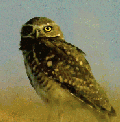

|
The CFHT Adaptive Optics Bonnette
|
Images of the galactic center in the near infrared (2.2 microns). The left image shows the galactic center as seen by a telescope located in a good site (Mauna Kea, Hawaii), using normal imaging techniques. The right image shows the same field, as seen with the Canada-France-Hawaii Telescope (CFHT) adaptive optics compensation system. The image is crisper, and a lot of details and new stars stand out. Note the diffraction rings around each star, which indicate that we have reached the ultimate resolving power of the telescope : in other word, the angular resolution can not be improved futher on this telescope. It would take a telescope of larger diameter to get a better resolution. The brightest objects have been saturated on purpose to reveal the fainter structures.
This image (not deconvolved) revealed the center of our galaxy with new details that allowed a team at CFHT, University of Montreal and the Dominion Astronomical Observatory (Victoria, Canada) to put new constraints on the central engine of our galaxy, the Milky Way. A very dense core, most probably a black hole, is believed to lie approximately at the center of this stellar field, as proved by new dynamical evidences : some stars close to where the black hole stands have apparent velocities above 2000 kilometers per seconds. The CFHT adaptive optics is a joint collaboration between CFHT, the Dominion Astronomical Observatory, the Observatory of Paris-Meudon and the French company Cilas. The infrared camera was provided by University of Montreal.
 207kB
207kB
Image of the galactic center at K band. The field of view is 13x13 arc
seconds. Left image show the field without AO compensation, right image
with AO compensation. North is on top, East on the left.
Also available : same image in blue
(207kB) or black & white compressed
postscript (215kB).
Submitted to IAU circular : High-resolution near infrared images of Comet 1995 O1 (Hale-Bopp) were taken on September 30, 6:05 UT using the Canada--France--Hawaii 3.6-m telescope. We used the newly commissioned adaptive optics system PUEO and the University of Montreal infrared camera MONICA. The images are diffraction limited at H (1.65 microns) and K (2.2 microns), that is 0.10 and 0.13 arcsec, respectively. We also obtained J band images (1.25 microns) at 0.10 arcsec resolution. The images have been processed to remove the fuzzy component probably due to sunlight scattering off a halo of dust particles in the comet's coma. The images have not been deconvolved.
The processed J, H, and K images of Comet 1995 O1 reveal a very active inner coma. Seven prominent jets extend radially from the nucleus and cross the instrument's 9-arc-second field of view; some of the jets appear to splinter into subjets. The most prominent jet activity lies to the northeast and east of the nucleus. All the jets flow from an elongated cloud of dust (oriented north-south), which surrounds the comet's starlike nucleus. This dense region is more extended to the north in the H image than in the J or K images. A deconvolved image of the starlike core reveals a knot of material 0.15 arc second north of the nucleus, corresponding to a distance of about 340 kilometers at the comet's present distance of 2.9 astronomical units. The nucleus itself is diffraction limited; an upper limit for its diameter was calculated to be 200 kilometers.


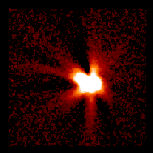 20kB each.
20kB each.



Comet Hale-Bopp : Upper images : J, H and K images of the jets. North is 100.5 degrees anti-clockwise from top, East is 10.5 degree anti-clockwise from top. The lower images show the nucleus at J, H and K. The field of view of the jets images is 8 arcsec, and 4.4 arcsec for the nucleus images.
This galaxy belongs to a class of objects known as "starburst galaxies". It undergoes an abnormal burst of star formation, as can be seen in the left--and compensated image : resulting from the star burst, some clumps that house clusters of red giant stars are revealed within these spiral arms. The cause of the starburst is still unknown, and these galaxies are subject to intense studies. These images will help a team at the Observatory of Paris-Meudon to understand better the physics of these objects and in turn enrich our understanding of how galaxies evolve. The left-hand image has been recorded with the adaptive optics compensation turned "on". The right-hand image is a simulation of what can typically be achieved from a good ground-based telescope without an adaptive optics system. The so-called angular resolution is 0.13 arcsec in the left-hand image and 0.7 arcsec in the right side image. The Canada-France-Hawaii telescope (CFHT) adaptive optics is a joint collaboration between CFHT, the Dominion Astronomical Observatory, the Observatory of Paris-Meudon and the French company Cilas. The infrared camera was provided by University of Montreal.
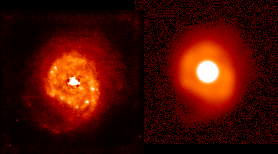 133 kB
133 kB
NGC7469 : Left image show the galaxy with AO compensation (plus
deconvolution). Right image is without AO compensation. The field of view
is 10x10 arc seconds.
Also available the same image in blue (133kB).
Submitted to IAU circular : Stephen O'Meara (Sky & Telescope), Francois Rigaut and Robin Arsenault (Canada-France-Hawaii Telescope) report the observation of a bright feature on the surface of Saturn. On September 25, 1996 at 10:22 UT, we took a high-angular-resolution I band image during an engineering run of the Canada-France-Hawaii adaptive optics bonnette. The detector was a thin CCD device. The instrument was mounted at the Cassegrain focus of the 3.6-m telescope. The image revels features to 0.18 arc second, including a highly detailed white spot in the planet's South Equatorial Zone. The spot is the focus of a sinewy white cloud that extends more than 100 degrees in longitude. This extensive white spot feature is separated into two distinct bands. The southern component contains a strong white condensation positioned just west of the central meridian (System I longitude 153 degrees). The condensation forms the core of a dense cloud that extends 20 degrees to the east in a wavelike fashion. The trail gradually thins then curves southward in a wide arc. The northern component of the cloud is nearly straight and forms a long, thin white band that parallels the southern edge of the ring system. It is strongest to the east, though, like its southern component, it has a faint extension that can be followed across the globe to the west. The northern edge of the South Equatorial Band is also scalloped with one prominent white cloud that loops northward around a dark condensation. This cloud then trails off to the west. Another fainter, wavy streamer extends east of the central condensation, but it appears to curve gently northward. The North Equatorial Zone also appears glazed with an amorphous white cloud that only shows hints of banding and wavelike structure. The image also reveals at least five spokelike features in the planet's B-ring, on the eastern ansa. The dark fingers are curved in a fashion that would indicate co-rotation with the planet.
 87kB
87kB
J and H images of 3 multiple systems in the Pleiades. The binary (left, J band) consists of two 0.7 Mo stars with a 0.088 arcsec projected separation (11 AU). The triple system on the middle image (J band) consists of two 0.1Mo stars with a projected separation of 0.09 arcsec (12 AU) and a third 0.4 Mo star 1.5 arcsec (195 AU) away. The triple system on the right image (H band) consists of two 0.7 Mo stars with a projected separation of 0.1" (13 AU) and a third 0.5 Mo star 0.6" (80 AU) away. The images are not deconvolved. These results are part of a large-scale survey of low-mass multiple systems in the Pleiades cluster (J. Bouvier/CFHT-Obs.Grenoble, F. Rigaut/CFHT, R. Doyon/Univ.Montreal).
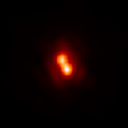
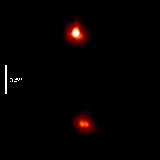
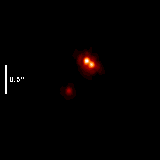 3kB each
3kB each
You can also get a large image of all the binary and triple stars found in this survey (uncompressed postscript, 715 kB, JPEG file, 30 kB or GIF file, 96kB). H3197 and mt61 are triple stars. H1553 is a very close double.